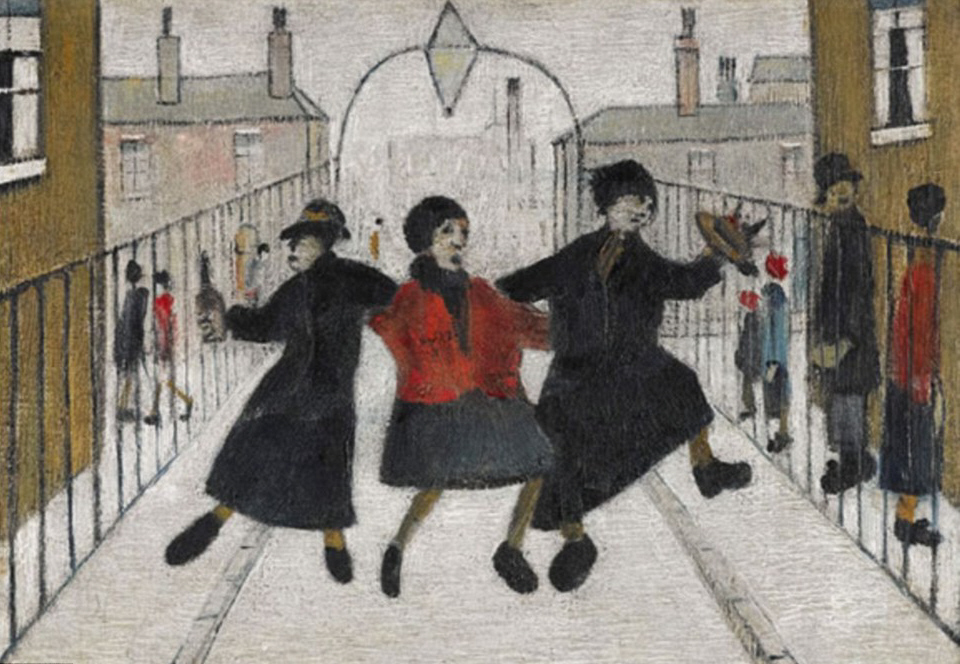

This work was painted in 1924 when Lowry was thirty seven years old.
The decor, the surroundings and the clothes may have changed over the years, but we can still see the same scenes today as three girls
make their way home after a night'clubbing'.
This painting has not been seen before and is expected to sell for around £ 600000, however, recently many of Lowry's paintings achieving
several times the estimate. So it can be anticipated that this painting will be sold
for well in excess of one million pounds.
The scene is probably of no specific area, but a generalisation by Lowry of an event that he saw.
The lifework of Mr Lowry the artist
Laurence Stephen Lowry began life in Rusholme, Manchester, November 1887, the only child of Mr R S Lowry from Ireland and his wife Elizabeth
(maiden name; Hobson).
He attended a neighborhood school in Victoria Park, but took private classes from William Fitz, before begining his work as a clerk for an agency of chartered
accountants in 1904,
that would show him the many sights he would later use for his paintings.
From 1905-1915 Lowry attended drawing and painting courses at the Municipal College of Artwork (later Manchester College of Art, now a part of Manchester Metropolitan University), where Lowry was tutored by the now well known an highly regarded artist, Adolphe Valette.
He moved to Pendlebury in Salford together with his parents in 1909, for almost forty years Lowry lived here. Throughout this time Lowry went to an art class at Salford School of Art, growing a strange, almost morbid curiosity for the city and industrial landscape. Lowry was fascinated by its people, who toiled night and day against incredible odds, to make a living for themselves, working long hours in terrible conditions, with little to show financially. Large families living in small terrace houses with barely sufficient food, and the Fever Van never far away.
Lowry exhibited with the Manchester Academy of Fine Arts from 1919, as well as showing paintings in the Paris Salon. By the early 1930s Lowry was exhibiting at the 'Royal Academy', London, and was awarded an honorary Master of Art at Manchester College in 1945, and Doctor of Letters in 1961. In 1962 he was elected to the Royal Academy, and given freedom of the City of Salford in 1965.
He lived in Mottram till he died in 1976; the people of Manchester showed an unprecedented homage to this great master of art.
Mr Lowry is without doubt, one of the most celebrated of British artists and his unique contribution to recording the interval, tradition and panorama of commercial Salford and Manchester is without parallel.
His work is a most distinctive and comprehensive report of the pre and post World War Two northern industrial towns. Many people affiliate Lowry with "matchstick figures", but he's recognized to have produced over 10,000 works, ranging from completed oil paintings to swiftly drawn sketches.
The local industrial scenes were his most frequent topics but he additionally painted seascapes and portraits. Lowry was an amazing humorist and had intense insight into human nature, characterising it without sentiment. Later in his life Lowry worked on producing paintings of figures either singly or collectively, invariably in opposition to a white background.
Throughout his lifetime, he also produced thousands of pencil drawings, these have become very collectable and the most detailed ones are very professionally drawn.
Lowry was not registered with any doctor; in 1976 he died at hospital from pneumonia.
He had little time for the financial sharks that would 'hound' him on a daily basis, and the galleries hoping to inherit a number of works in Lowry's will, they kept in close contact with him throughout his old age, only to learn that Lowry had left all his paintings to a lady, with the same surname (Carol Ann), who had written him a letter when she was a young girl, asking how she may learn to be an artist.
His standing as one of the foremost British artists of the 20th Century was strengthened when the painting "Going To The Match" was sold for a record
£1.9 million to the Manchester based 'Professional Footballers Association'.
Manchester's newly built museum gallery, The Centre in Salford Quays, now holds a major collection of his work.
There are relatively few signed prints now available. Many artists such as David Shepherd
signed hundreds of titles, and each edition can sometimes be in excess of a thousand.
But Lowry agreed to only fifty four signed prints, and each title ranged from 95 to 850 in the edition. (75 in the case of the lithograph signed prints)
Once the signed prints had been published, the work was copyrighted and the original printing plates were destroyed so that apart from the original painting
only the agreed number of signed prints were produced.
Needless to say that after 50 or so years , from an edition of 850, there are a mere fraction of the edition that still exists in good condition.
Many will have been lost damaged (often by the glass breaking), being stored in damp conditions or the case of several titles,
fading, due to the printers who have not used the lightfast inks and acid free paper.
The highest price for one painting was £1.9 million when 'Going To The Match' was sold in 1999.
Later in 2007, the sale of the Lowry's painting "Daisy Nook Fair" achieved £3.8m.
May, 2011 "The Football Match" painting (not 'Going to the match') by Lowry was sold for £5,641,250.
November, 2011 The 1960 painting of 'Piccadilly Circus' by L.S.Lowry was sold for £5,641,250
Recently the 'Going to the Match' painting has been valued at £6,000,000-10,000,000